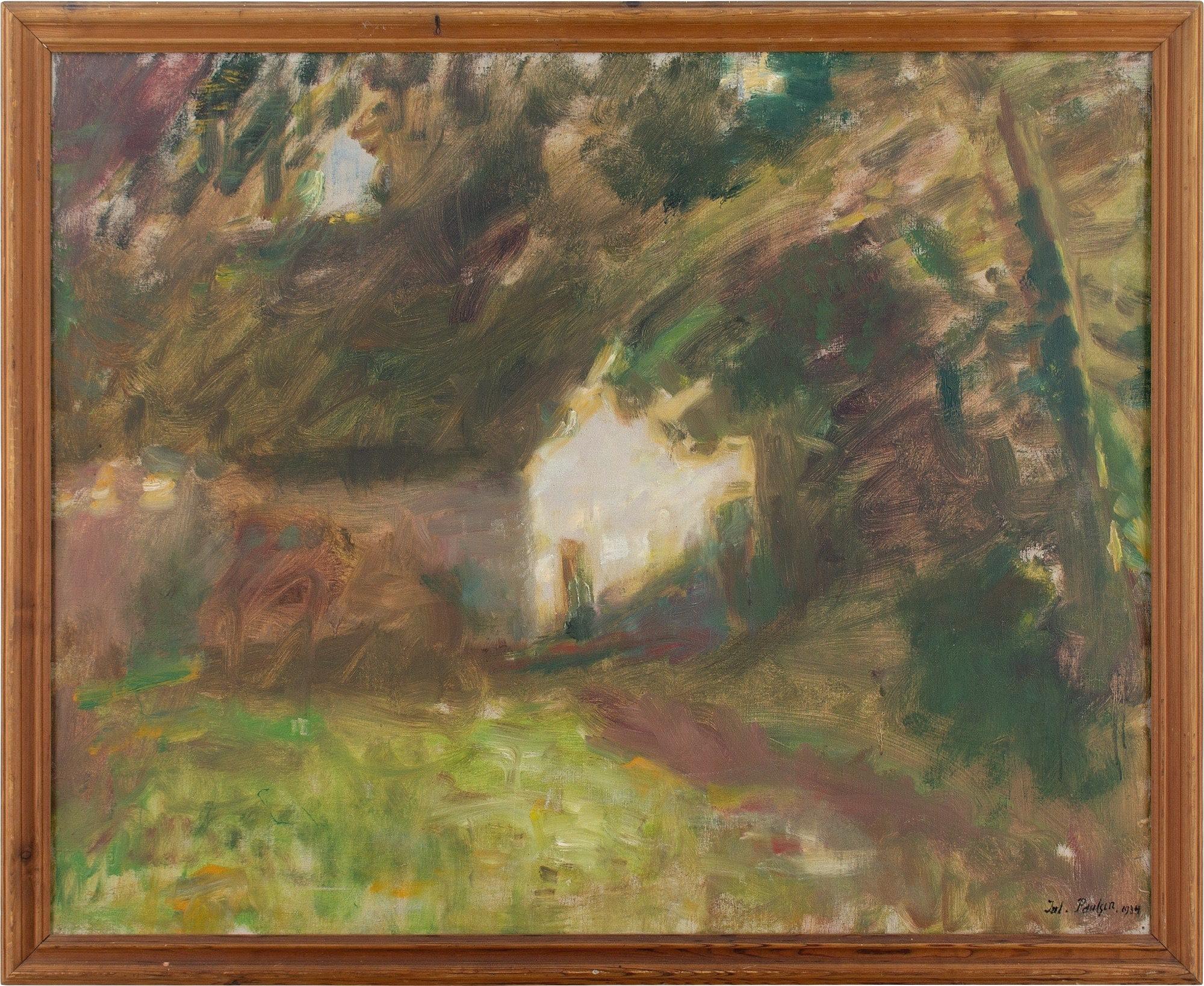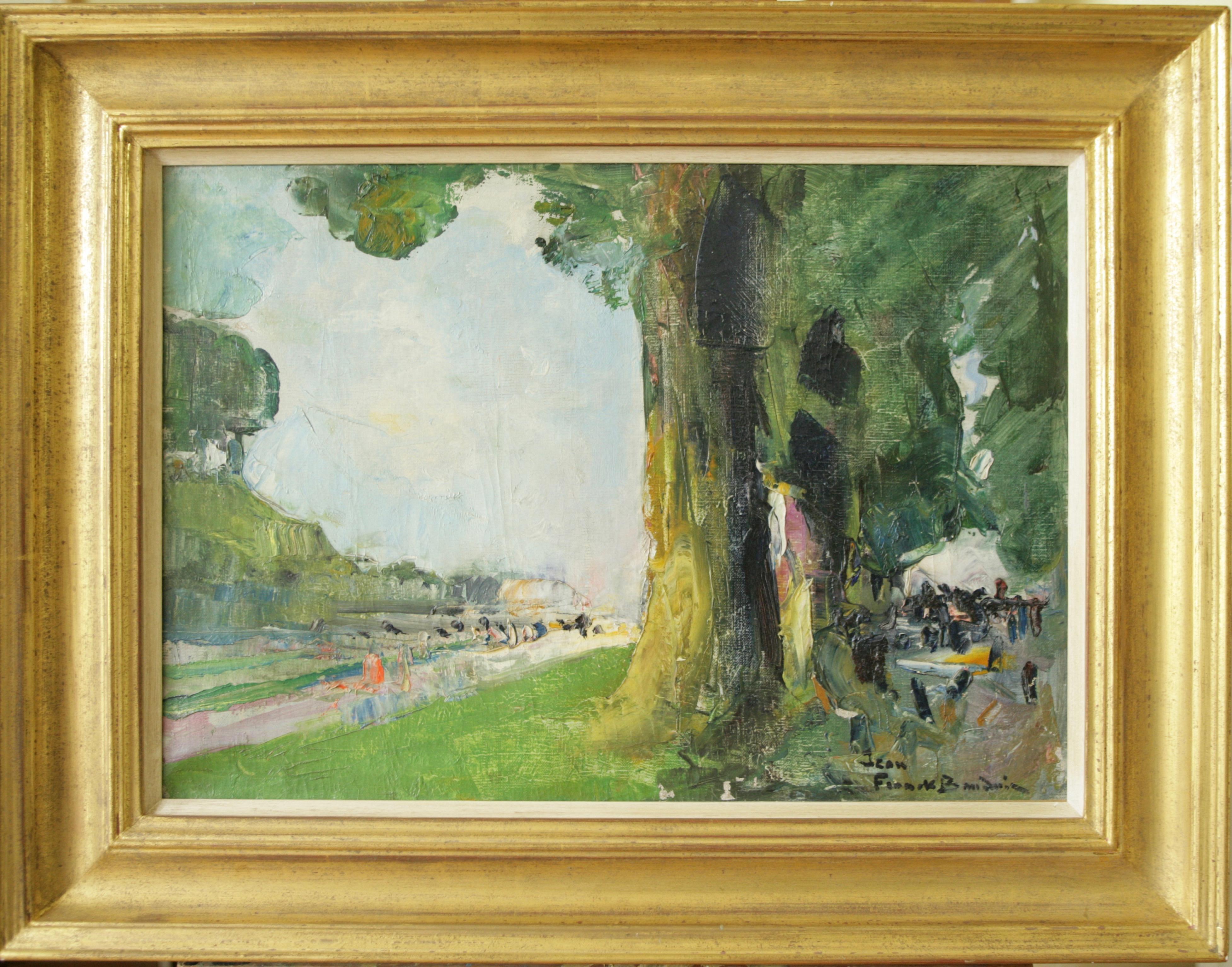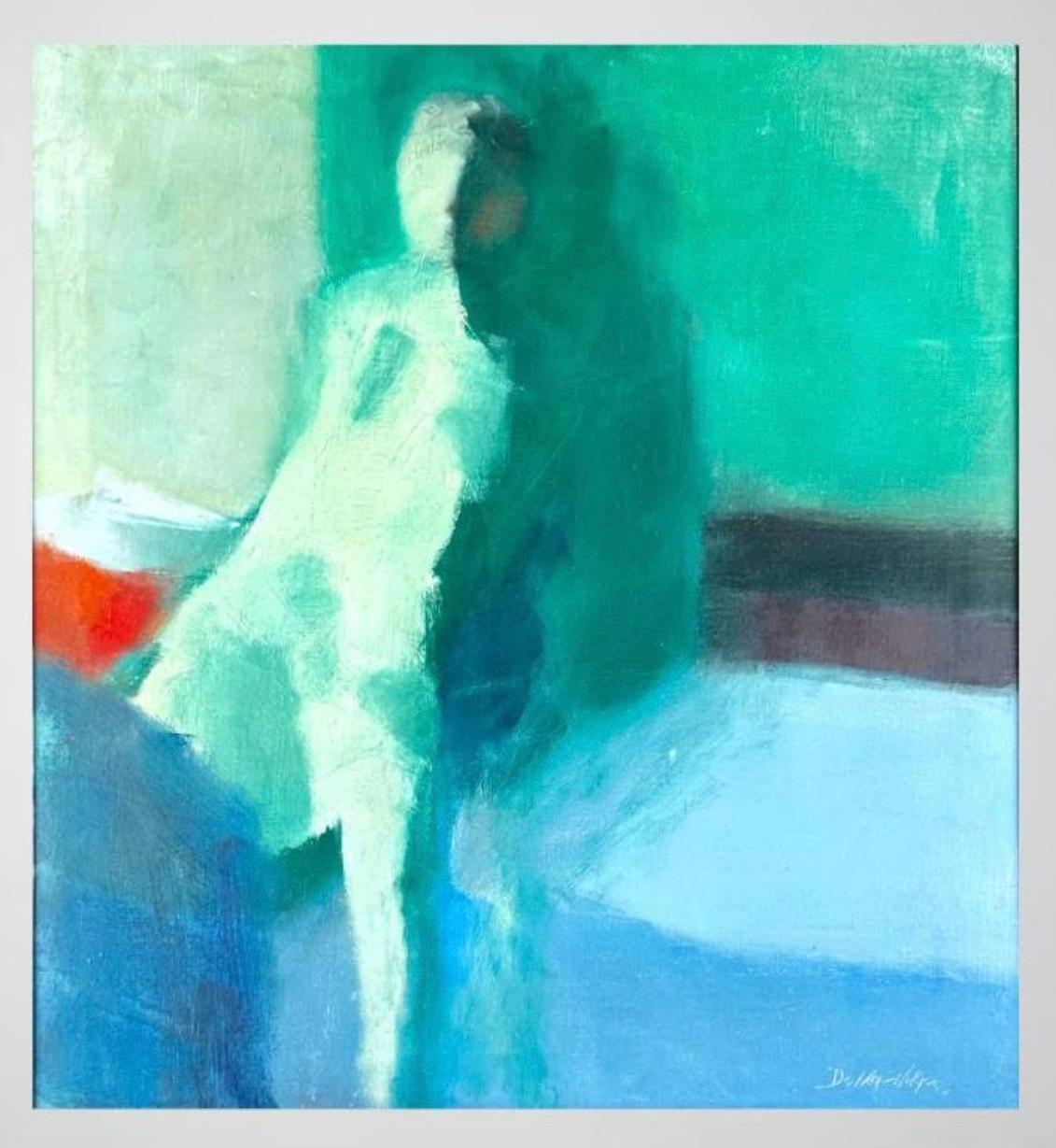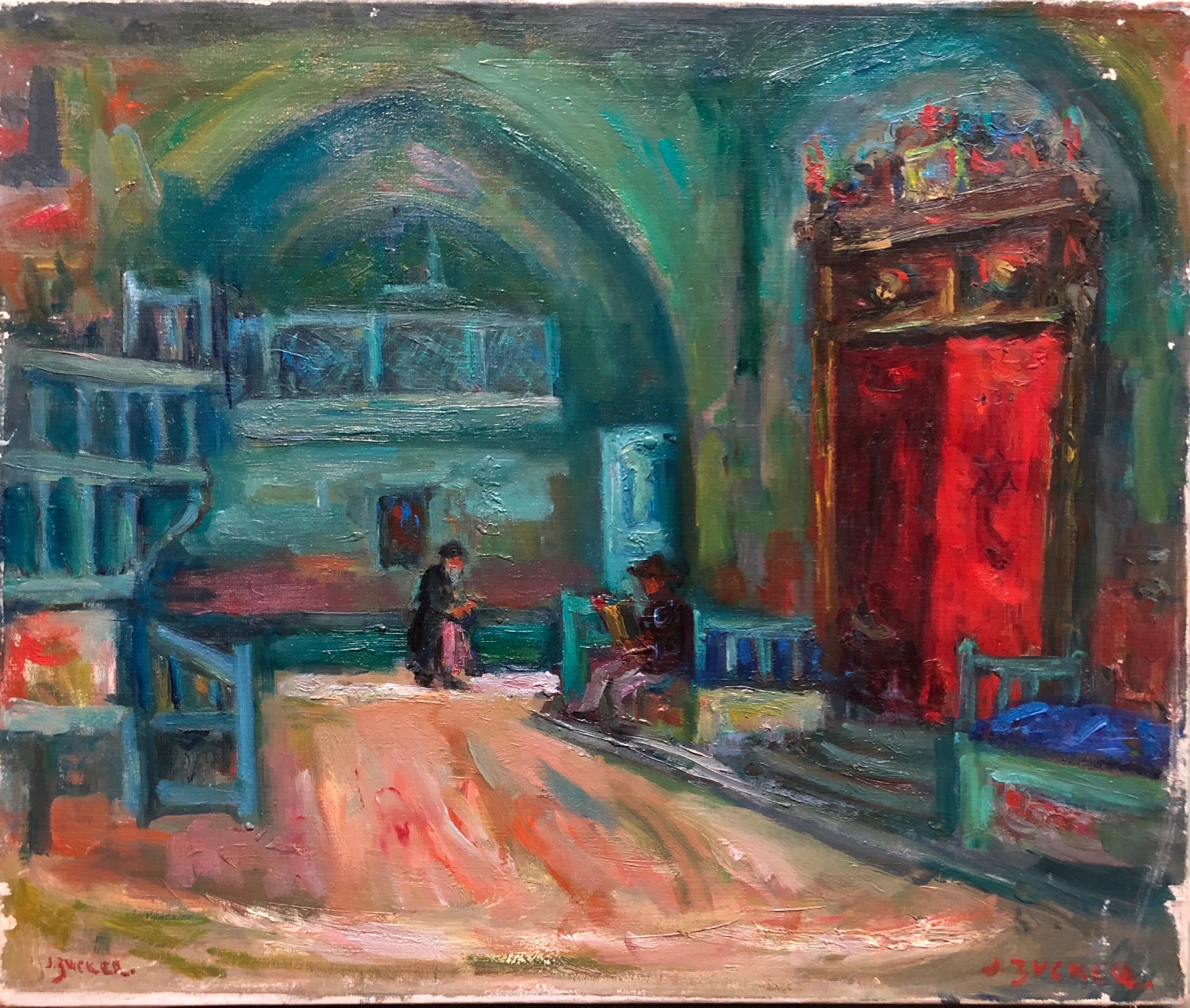Jacques Zucker"Connecticut Seascape" Post-Impressionist Costal Oil Painting on Canvas Framed20th Century
20th Century
About the Item
- Creator:Jacques Zucker (1900 - 1981, American)
- Creation Year:20th Century
- Dimensions:Height: 28.5 in (72.39 cm)Width: 32.5 in (82.55 cm)Depth: 2.5 in (6.35 cm)
- Medium:
- Movement & Style:
- Period:
- Condition:The painting is in very good condition for the time period besides some light undulation in the center area, and some in-paint to repair damage from age along the left and right edges of canvas and the frame also shows some ordinary wear from age.
- Gallery Location:New York, NY
- Reference Number:
Jacques Zucker
Jacques Zucker was a prolific artist whose works are exhibited in museums and galleries around the world. Being heavily influenced by artists such as Chaim Soutine, Marc Chagall and Pierre-Auguste Renoir, we can see hints of their styles suggested in many of his works. Although he was very fond of these artists, Zucker's works are mainly impacted by his travels to Paris, America and France. Many of his works depict city street scenes, the seashore, flower still life and portraits of friends and relatives. He has developed a style completely apart from his influences, creating works that are rich in texture, color and emotion.
- ShippingRetrieving quote...Ships From: New York, NY
- Return PolicyA return for this item may be initiated within 7 days of delivery.
- "Vue depuis L'église de la Madeleine" French Post-Impressionist Plein Air SceneBy Lucien AdrionLocated in New York, NYA stunning and masterful depiction of a Parisian street view from the 20th Century. It seems as though the artist executed this painting at the steps of 'L'église de la Madeleine' an...Category
1940s Post-Impressionist Landscape Paintings
MaterialsCanvas, Oil
- "On the Stairwell" Impressionist French Street Scene Oil Painting on CanvasBy Jacques ZuckerLocated in New York, NYThis painting depicts a landscape scene of a town scene of figures on the stairwell. The attractive perspective is what makes this painting so interesting and desirable; there is a s...Category
20th Century Post-Impressionist Landscape Paintings
MaterialsOil, Canvas
- "Place Du Tertre " Impressionist Oil Painting with Figures in Parisian VillageLocated in New York, NYThis painting is a tremendously vivid and alive street scene from Paris in the 20th Century, depicting The Place du Tertre. This square is in the 18th arrondissement of Paris, France. Only a few streets away from Montmartre's Basilica of the Sacré Cœur and the Lapin Agile...Category
Mid-20th Century Post-Impressionist Landscape Paintings
MaterialsOil, Canvas
- "Place de l'Opéra" Post-Impressionist Parisian Street Scene Oil Painting CanvasBy Jean SalabetLocated in New York, NYA beautiful oil on canvas painting by the French artist, Jean Salabet. Salabet was a Parisian painter known for his colorful cityscapes depicting the times of his generation. His wor...Category
20th Century Post-Impressionist Landscape Paintings
MaterialsCanvas, Oil
- "Snow at Washington Square Park" Impressionist Painting Style Johann BerthelsenLocated in New York, NYA charming depiction of Snow in New York City by Washington Square Park on a cold snowy evening with city lights and buildings captured in the distanc...Category
Mid-20th Century Post-Impressionist Landscape Paintings
MaterialsCanvas, Oil, Board
- "Pont De La Concorde" Post-Impressionist Oil Painting Across the Seine in ParisBy Lucien AdrionLocated in New York, NYThis work by Lucien Adrion is a wonderful representation of his impressionistic works depicting the "Pont De La Concorde" bridge across the Seine in Paris with the Eiffel tower in th...Category
Early 20th Century Post-Impressionist Landscape Paintings
MaterialsCanvas, Oil
- Judgment of Paris, Georges Van Zevenberghen, Brussels 1877 – 1968, SignedLocated in Bruges, BEJudgment of Paris Van Zevenberghen Georges Brussels 1877 – 1968, Belgian Painter Signature: Signed bottom left and dated 37 Medium: Oil on canvas Dimensions: Image size 50 x 60 cm,...Category
Early 20th Century Post-Impressionist Nude Paintings
MaterialsCanvas, Oil
- Julius Paulsen, Wooded Landscape With Cottage, Oil PaintingBy Julius PaulsenLocated in Cheltenham, GBThis early 20th-century expressive landscape painting by Danish artist Julius Paulsen depicts a cottage nestled in the woods. It’s painted quickly with a rhythmical approach and poet...Category
Early 20th Century Post-Impressionist Landscape Paintings
MaterialsCanvas, Oil
- Au Pied mon ArbreBy Jean-François BaudoinLocated in Pollenca, Illes BalearesBorn in 1870 in Saint-Martin-de-Ré, a beautiful island off the coast of La Rochelle, Jean Franck Baudoin was immersed in the world of art from an early age. His father was a sculptor who worked from a studio in Paris and realizing his son’s latent talents sent him there to live with his uncle. Just nineteen, he became heavily influenced by the Impressionist painters, particularly Monet, Degas and Van Gogh. Although he was already painting, his family thought it wise to get him some formal training. To this end, he enrolled at the Academie Julian where he counted William Bouguereau and Tony Robert-Fleury amongst his teachers and Marcel Baschet and Henri Royer...Category
Mid-20th Century Post-Impressionist Landscape Paintings
MaterialsCanvas, Oil
- Modernist Oil Painting Moody Fauvist Abstract Nude Figure Ralph Della VolpeLocated in Surfside, FLRALPH DELLA-VOLPE (1923-2017) Fine Art Painter, American Contemporary Oil on canvas Hand signed lower right Artist Signed, Abstract Oil on Canvas. Figure in the distance. Approx: 30" x 27 1/2" framed, 26 1/2" x 23 1/2" canvas. TRAINING: National Academy of Design The Art Students League, NYC Ralph Eugene Della-Volpe's semi-abstract paintings of often simplified, minimalist, beach scenes and anonymous portraits "convey profound awareness of mood and character", and his paintings are hardly as literal as they may first appear (Arts Magazine. "New York Exhibitions". 1965). His brightly-colored, light-infused, ornamental compositions bring together aspects of many modernist art movements including Fauvism, Impressionism, Symbolism, and abstraction. Della-Volpe first studied painting at the prestigious National Academy of Design before joining the Army during World War II. As a soldier, the artist saw action on Utah Beach, winning a Purple Heart, and his experiences undoubtedly affected his later artistic style. The Fauvist "coloristic exuberance" found in the works beginning in the mid 1960's, with their vibrant fuschias and yellows, seem to offset what could be an otherwise solemn tone to many of his works at the time. Upon his return from military service, Della-Volpe’s style evolved significantly. In the years following the second world war, his work was solemn, imbued with a quiet darkness. Over time, this darkness faded: by the 1950s, influenced by his time at the Art Students League, his oeuvre was overtaken by the tenants of Abstract Expressionism. Paintings from this period boast bold brushwork, energetic compositions, and strong color. Although the next decade saw Della-Volpe trade expressionist abstraction for figuration, his love of color continued to shine through his work.Della-Volpe took a teaching position as the first artist-in-residence at Bennett College in Millbrook, New York where he remained for 28 years, serving as chairman of the Art Department for most of that time. Obviously influenced by impressionism 's preoccupation with the treatment of light, Della-Volpe's own works have a "faultless tonal quality, with its sense of failing light—the areas of silvery gray deepening into rosy tans" (Arts Magazine. "In the Galleries". 1960). Della-Volpe has exhibited widely throughout his career and has lectured on art at colleges, universities, and galleries across the country. He was included in the show Abstraction: 1950-1970 at Taylor Graham, Greenwich CT. A survey of post-war abstract art movements including Abstract Expressionism, Color Field, Hard Edge, Minimalism and Op-Art. Adolph Gottlieb, André Cottavoz, Carl Robert Holty, Cleve Gray, Friedel Dzubas, Ilya Bolotowsky, James Hiroshi Suzuki, Norman Bluhm, Ralph Della-Volpe, Theodore Appleby...Category
20th Century Fauvist Abstract Paintings
MaterialsCanvas, Oil
- Synagogue Interior Jerusalem French Judaica Oil Painting Israeli Bezalel SchoolBy Jacques ZuckerLocated in Surfside, FLGenre: Post Impressionist Subject: Landscape Medium: Oil Surface: Canvas Country: France Dimensions: 24" x 20" Jacques Zucker was born in 1900 in Radom, Poland. He was a notably famous Jewish American artist mostly known for his expressionist figure paintings. In his young years he traveled to Palestine to study fine arts at the Bezalel Art School in Jerusalem. In 1917 he joined the British Royal Fuesiliers under the leadership of General Allenby to liberate Palestine from the Turks. After the first World War he settled in Paris, where he continued his studies at Académie Julian and Academie Colarossi. He then emigrated to the United States in 1922 and continued his art studies at the National Academy of Design. He supported himself by designing jewelry. In 1925 he returned to Paris and studied at the Academie de la Grande Chaumier et Colarossi. During the Depression he worked for the WPA. From 1928 he took part in the Paris Salons: Autumn and the Tuileries. His works are expressionistic variations in the type of the Ecole de Paris. As a protégé of both Chaim Soutine and Renoir, hints of their style can be observed in much of his own work. Zucker’s style, that may have been influenced from the art of artists such as Marc Chagall, took pride in being an “internationalist”, standing the art of painting in its highest expression is universal no matter where the canvas was created. People who respond to quality in art will understand the beauty and meaning, in their own land or in a foreign land, this was his main idea behind his artworks that was exhibited in numerous solo show in leading galleries and museums in New York, Paris, Tel Aviv, and other art centers. Claude Roger-Marx of Figaro Litteraire, dean of French art critics, write a comprehensive study of Zucker’s illustrated with 135 color and black and white plates. He traveled widely, including Italy, Spain, Portugal, Mexico and Israel. From then on Zucker lived alternately in New York and Paris, maintaining homes in both places, and spent considerable time painting in Mexico, Portugal, Greece, and Israel. Zucker's post-impressionist works including town and landscapes, still-lives, and portraits, are part of an array of permanent installments in numerous museums and private collections in Tel Aviv, including the Joseph Hirschorn collection in Washington, D. C., the Museum of Modern Art in Paris, and the Bezalel Art Museum in Jerusalem. In 1947 he settled in Arcueil near Paris. Zucker died in 1981 in New York. The School of Paris, Ecole de Paris, was not a single art movement or institution, but refers to the importance of Paris as a center of Western art in the early decades of the 20th century. Between 1900 and 1940 the city drew artists from all over the world and became a centre for artistic activity. School of Paris was used to describe this loose community, particularly of non-French artists, centered in the cafes, salons and shared workspaces and galleries of Montparnasse. Before World War I, a group of expatriates in Paris created art in the styles of Post-Impressionism, Cubism and Fauvism. The group included artists like Pablo Picasso, Marc Chagall, Amedeo Modigliani and Piet Mondrian. Associated French artists included Pierre Bonnard, Henri Matisse, Jean Metzinger and Albert Gleizes. The term "School of Paris" was used in 1925 by André Warnod to refer to the many foreign-born artists who had migrated to Paris. The term soon gained currency, often as a derogatory label by critics who saw the foreign artists—many of whom were Jewish—as a threat to the purity of French art. Art critic Louis Vauxcelles, noted for coining the terms "Fauvism" and "Cubism", Waldemar George, himself a French Jew, in 1931 lamented that the School of Paris name "allows any artist to pretend he is French. it refers to French tradition but instead annihilates it. The artists working in Paris between World War I and World War II experimented with various styles including Cubism, Orphism, Surrealism and Dada. Foreign and French artists working in Paris included Jean Arp, Joan Miro, Constantin Brancusi, Raoul Dufy, Tsuguharu Foujita, artists from Belarus like Michel Kikoine, Pinchus Kremegne, and Jacques Lipchitz, the Polish artist Marek Szwarc and others such as Russian-born prince Alexis Arapoff. A significant subset, the Jewish artists, came to be known as the Jewish School of Paris or the School of Montparnasse. The core members were almost all Jews, and the resentment expressed toward them by French critics in the 1930s was unquestionably fueled by anti-Semitism. Jewish members of the group included Emmanuel Mané-Katz, Chaim Soutine, Adolphe Féder, Chagall, Moïse Kisling, Maxa...Category
Mid-20th Century Post-Impressionist Landscape Paintings
MaterialsCanvas, Oil
- French Semi Abstract Expressionist Color Field Impasto Oil Painting Jean HelleuLocated in Surfside, FLJean Helleu (French, 1894-1985) A painter, watercolorist and designer born in Paris, France. The son of Paul-César Helleu. (a French oil painter, pastel artist, drypoint etcher, an...Category
Mid-20th Century Post-Impressionist Landscape Paintings
MaterialsCanvas, Oil






